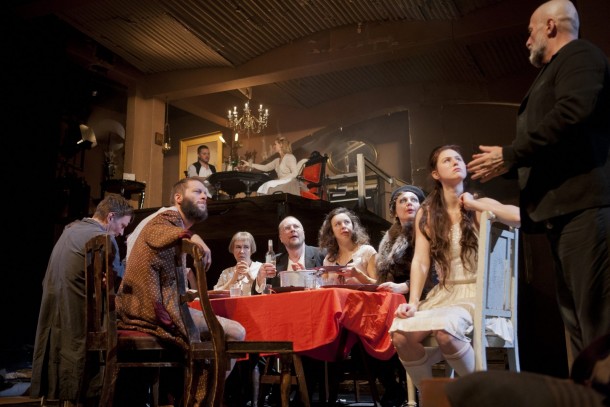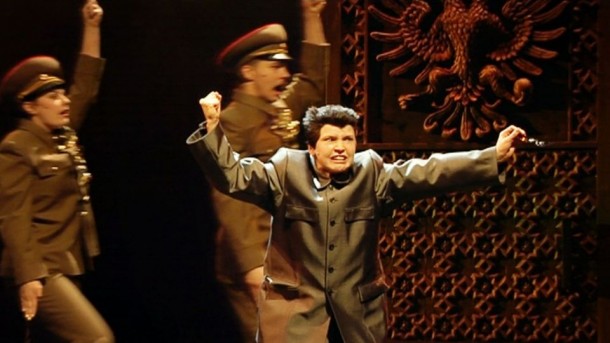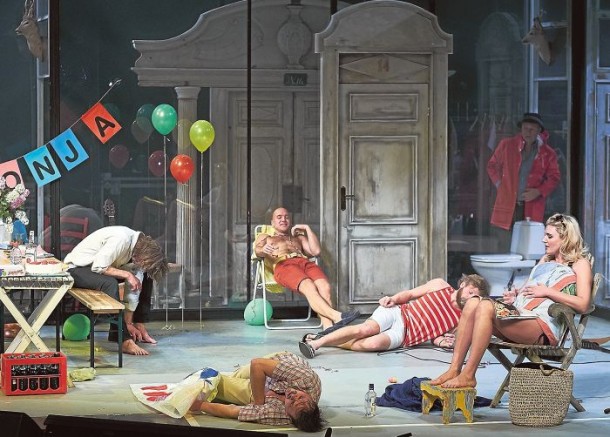The political tensions that have recently developed between Russia and the West have had an impact on the reception of Russian culture and theatre in Finland. Over the past year, Finnish theatre companies and particularly the Finnish National Theatre have produced a significant number of Russian plays and Finnish plays about Russia. This is partly a coincidence, because the decisions regarding repertoire were made before the current situation arose. While not all productions of classics take a stance on contemporary politics, they all reflect the time of their making. The theatre has increased and capitalized on the awareness of the Russian crisis, but it has also offered a human perspective on the debate.
In recent years, theatre directors have approached Anton Chekhov’s plays from various angles. Uncle Vanya in particular has repeatedly been regarded as topical. After the turn of the millennium, it has been staged in more than ten Finnish theatres, and there are almost as many productions of Chekhov’s three other great plays. During the 2014-2015 theatre season, Uncle Vanya was in the repertoire of three theatres, and the almost simultaneous premieres of the Finnish National Theatre and the Helsinki City Theatre sparked a lively debate on the artistic and dramaturgical choices of each production. In addition, a Swedish production of Uncle Vanya was part of the Tampere Theatre Festival program. The National Theatre also staged Maxim Gorky’s classic play The Lower Depths and Pirkko Saisio’s new work, SLAVA! Honour, which is “a grand opera” about contemporary and previous oligarchs of Russia.
The idea for SLAVA! Honour emerged a couple of years before the political crisis evolved. The decision to include it in the repertoire of the National Theatre was also made a long time ago, but the production itself was affected by the tension caused by the war in Ukraine that had broken out by the time of the premiere. SLAVA! Honour attracted a large audience thanks to its dynamic character and the music that drove the events. The music was performed by singing actors and a band led by Jussi Tuurna. The show also included a game where the audience was invited to identify characters caricatured by the actors. SLAVA! Honour traveled across the history of Russia—all the way from Grigory Potemkin, Catherine the Great, and Siberian prison camps to the present time and its political events. Barriers were broken down on all fronts. The characters included “Volodya” Vladimir Putin (an unrestrained caricature delivered by Timo Tuominen) side by side with Kim Jong-un (petite actress Marja Salo as a padded doll) and actor Gerard Depardieu (the imposing Juhani Laitala), who had publicly supported Putin, as well as “Christ-Conchita Wurst” (Janne Marja-Aho, a lookalike of the 2014 Eurovision Song Contest winner), who descended from Heaven. Directed by Laura Jäntti, SLAVA! Honour could be characterized as a carnivalesque and racy satire with occasional sentimental moments. The revue-like numbers. were loosely tied together by charming everyman characters, Obeda (Puntti Valtonen) and Popeda (Juha Muje), who moved their stout figures deftly and made a good effort to learn to cope in the world ruled by oligarchs.
An indication of the topicality of SLAVA! Honour is that the Finnish National Theatre decided to use Russian supertitles in the show—although it is uncertain whom the supertitles were supposed to serve. Since the early 1990s, a great number of Russians have moved to Finland, but most of them have learned to speak Finnish, so it is unlikely that they would need a translation. Furthermore, the number of Russian tourists has considerably decreased due to the economic difficulties in Russia. Therefore, the Russian supertitles were just a nice gesture, not a response to a great demand. There was no need to try to attract new audiences, because the shows were still almost sold-out in autumn 2015. Faithful to the chosen style, the show itself was built on clichés, which consolidated critical attitudes and provoked the spectators to view the present time from a historical perspective.
The political message of the play was unambiguous and indisputable and the critical images included morally concerned subtexts. The National Theatre organized a series of open panel discussions, which provided an opportunity for more profound analysis, as the panel members were Finland’s leading experts on Russia. Every seminar attracted a great number of people. In contrast to the truncated and superficial news coverage, the seminars invited the audience to see the political situation from multiple perspectives with a more humane approach. SLAVA! Honour depicted the distress of ordinary people being oppressed, whereas the seminars highlighted the broader social and cultural context. These Finnish contemporary productions intensified the humanity of the Russian classics. They did not attempt to make a political statement, but instead, they broke new ground by depicting universal human themes.

The Lower Depths adapted and directed by Janne Reinikainen. Photo courtesy of the Finnish National Theatre.
Maxim Gorky’s The Lower Depths was staged at the Finnish National Theatre for the first time in 1903. Since then, the play has been produced once or twice in each decade. Most of the productions have attracted little attention, with a few exceptions that have made a greater emotional impact. Janne Reinikainen adapted The Lower Depths with Eva Buchwald and directed it in autumn 2014 to celebrate the fiftieth anniversary of the Small Theatre of the Finnish National Theatre (set design by Kati Lukka and costume design by Tarja Simonen). The production revealed the inner character of a classic: the beauty and dignity that are inherent in extreme human suffering. The program of The Lower Depths included Boris Pasternak’s poem, Hamlet: “I am trying, standing in the door, / To discover in the distant echoes / What the coming years may hold in store“ (translation by Ann Pasternak Slater). In the dreamlike production, the mood changed between silent and riotous scenes at a controlled pace. The acting area was not very deep. The set design included spaces built side by side and on top of each other, which emphasized the audience’s role as a witness. The plot was quite loose, so the spectators’ attention focused on the cast’s stage presence. The set design and even the most grotesque characters were poetically impressive rather than shocking.
The topicality and the meaning of unconnected scenes were confirmed at the end of the intense performance as the curtain came down and the actors stepped in front of it in character. A text written in large letters on the curtain said, “What is a human being?” The characters told the audience what would happen to them in the future. Hardly anything would change; good and evil would continue side by side. The Lower Depths embodied a transition from the naturalism of the time when Gorky wrote his text to existentialism and all the way to contemporary theatre that leaves the responsibility for making moral evaluations to the spectators.
Uncle Vanya (dir. Paavo Westerberg) was premiered at the Finnish Theatre in September 2014. The set design included a house that filled the whole stage of the Main Theatre. The corridors of the house had many doors and the characters would walk in and out without meeting each other. In many of the recent productions of the Main Theatre, the set designs have made good use of the large space by highlighting its depth. However, in Uncle Vanya, the set reached towards the ceiling and thus referred to Chekhov’s mention that the house had twenty-six large rooms. The most impressive aspect of Uncle Vanya was the intensity of character portrayal and the actors’ abilities to use their physical beings to express what cannot be said in the dialogue. When watching this production, it was easy to understand why Chekhov referred to his plays as comedies. The fact that the characters kept missing each other was tragic to the point of being comical, but instead of being amused, the audience felt compassion.
The National Theatre’s history with Chekhov dates back to occasional productions at the beginning of the twentieth century. However, the long tradition of Chekhov stagings did not properly start until the late 1940s with the rise of stage director Eino Kalima, who was greatly inspired by Stanislavsky’s early work. This was followed by significant productions directed by Kalima’s Russian colleagues, attempts by Finnish directors to bring the themes of the texts to the present day and, at the turn of the millennium, the complete detachment from the historical time of the play. Timelessness and the metaphorical quality of the visual side of the performance connected the new productions to the historical tradition of Chekhov productions. Another intertextual element resulted from ghosting of the cast’s previous work, for example, Krista Kosonen’s impressive roles in two productions directed by Andriy Žoldak: the intense Uncle Vanya in the small Klockrike Theatre and the visually impressive The Cherry Orchard of the Turku City Theatre as well as Emmi Parviainen’s powerful role in The Cherry Orchard directed by Mika Myllyaho for the National Theatre.
The fact that the Helsinki City Theatre had their premiere of Uncle Vanya a day later than the Finnish National Theatre naturally elicited comparisons of the two versions, and each had its supporters. Hungarian director Tamás Ascher is renowned for his Chekhov stagings, and also the Helsinki City Theatre has a history with Chekhov, which has been greatly affected by the previous Managing Director, Ralf Långbacka, and his Chekhov and Brecht projects. Ascher’s rendition of Uncle Vanya was a traditional character drama, which foregrounded the relationship between Vanya (Santeri Kinnunen) and Astrov (Martti Suosalo) and gave Kinnunen in particular an opportunity for versatile interpretation that was rich in nuance. The National Theatre highlighted general, inconsolable longing, whereas one could see the City Theatre production as a depiction of Astrov and Vanya’s friendship, where the female characters served as catalysts rather than active agents. The City Theatre production interpreted Chekhov’s actual text rather than what was suggested between the lines. Modern traits such as the sound of a motorcycle remained unconnected. The production retold the old story without focusing on specific themes or new perspectives. Chekhov’s play will survive with such approaches, too, but this is an indication of the powerful status of the canon rather than the theatre makers’ interest in breaking it, which then leads to the renewal and reconsolidation of the canon.
In Chekhov’s prerevolutionary life, and in his plays that depict that time, the borders of Russia were fluid. For example, the characters of Uncle Vanya travel to Kharkov, Ukraine. Similar to other classics, rather than painting an image of Russia, the setting of Chekhov plays have typically been adapted to the cultural context of the performance. This was the case, for example, when Kristian Smeds directed Three Sisters in Finland at the turn of the millennium and redefined Vershinin as a specialist who has been summoned to solve the financial problems of a small town, or when Reko Lundán set Uncle Vanya in a village store in Eastern Finland. Another interesting case was Uppsala City Theatre’s rendition of Uncle Vanya at the Tampere Theatre Festival. The play was set in Sweden and director Yana Ross had made the text more topical by making overt references to the state of the contemporary world, including Vladimir Putin’s destructive impact on Russia, wars of the Arab world, the refugee question and the consequences of destruction of nature on democracy. Ross had set the events in Sweden, but she opened a view from Sweden to the world. The anachronistic political comments imitated the Nordic intelligentsia’s debate on the state of the world. Ross replaced the farm with a poorly managed hotel and added a new character—a guest who followed the events curiously, and thus highlighted the inefficiency of the hotel staff. The professor was Swedish, and, understandably, he suggested that they buy a villa in Majorca, Spain, rather than Finland
The Uppsala City Theatre production did not rely on metaphors. The messages were voiced directly and the characterization was ironic, but fundamentally realistic. Even though the expectant mood of the beginning seemed to lead to different directions and some of the additional political comments seemed unconnected, Astrov’s (Yngve Dahlberg) great monologue about the destruction of nature—and, at the same time, human beings—as a result of indifference and greed, tied the themes irrefutably together. Astrov did not show maps or speak in metaphors, but declaimed what he had to say about the acute problems that ail the modern man. The director has said that she approached the play from Sonya’s perspective and indeed, Sonya’s (Emelie Wallberg) role turned into a recognizable portrait of a young lady. However, maybe the most unexpected aspects of the performance were found in Yelena (Linde Kulle), who—contrary to tradition—blended with the rest of the characters and behaved quite normally. The character (and possibly the actress), who was visibly pregnant, embodied Astrov’s bleak vision of the future. We did not expect Yelena to pick up Astrov’s pencil as a souvenir. Faithful to the chosen approach, they had “goodbye sex.” Swapping lines between the characters helped to create a sense of a community.
Translated by Sarka Hantula
Professor Emerita Pirkko Koski was responsible for the Department of Theatre Research in the Institute of Art Research at the University of Helsinki, and the director of the Institute of Art Research until the end of 2007. Her research concentrates on performance analysis, historiography, and Finnish theatre and its history. She has also edited several anthologies about Finnish theatre, and volumes of scholarly articles translated into Finnish.
European Stages, vol. 5, no. 1 (Fall 2015)
Editorial Board:
Marvin Carlson, Senior Editor, Founder
Krystyna Illakowicz, Co-Editor
Dominika Laster, Co-Editor
Editorial Staff:
Elyse Singer, Managing Editor
Clio Unger, Editorial Assistant
Advisory Board:
Joshua Abrams
Christopher Balme
Maria Delgado
Allen Kuharsky
Bryce Lease
Jennifer Parker-Starbuck
Magda Romańska
Laurence Senelick
Daniele Vianello
Phyllis Zatlin
Table of Contents:
- Avignon the 69th Festival, July 4 to 25, 2015: Discovery Beyond The Classics by Philippa Wehle
- The 2015 Oslo International Festival at Black Box Theatre by Andrew Friedman
- The 2015 Theatertreffen by Marvin Carlson
- A Feminist Tuberculosis Melodrama: Melek by Theatre Painted Bird by Emre Erdem
- Nachtasyl at the Berliner Schaubühne: A Radical View of Gorky’s The Lower Depths by Beate Hein Bennett
- From Spectacular to Minimalist: Four Plays in Madrid, April 2015 by Phyllis Zatlin
- European productions at Montreal’s Transamériques Festival 2015 by Philippa Wehle
- Childish or Adult? Recent productions in Germany by Roy Kift
- Russian Drama in Finland by Pirkko Koski
- Troubling Cross-Currents in the Budapest National Theatre by Marvin Carlson
- Spain: Engaging with la Crisis Through Theatre by Maria Delgado
- Life and Death in the Emergency Room: Linus Tunström’s Faust 1 at the Staatsschauspiel Dresden by Bryce Lease
Martin E. Segal Theatre Center:
Frank Hentschker, Executive Director
Marvin Carlson, Director of Publications
Rebecca Sheahan, Managing Director
©2015 by Martin E. Segal Theatre Center
The Graduate Center CUNY Graduate Center
365 Fifth Avenue
New York NY 10016








